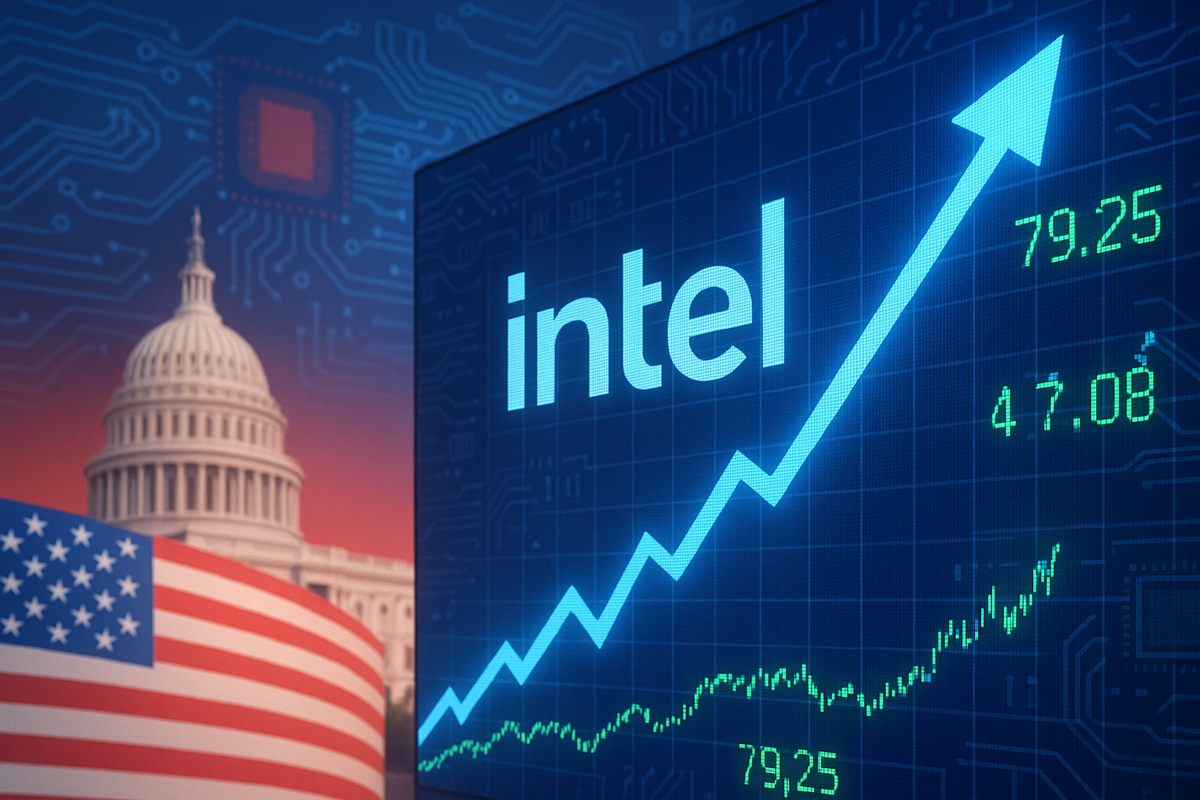
Intel Corporation's (NASDAQ: INTC) shares experienced a dramatic surge on Thursday, August 14, 2025, climbing over 7% in regular trading, fueled by explosive reports that the U.S. government is considering taking a direct equity stake in the struggling chipmaker. This unprecedented move, coupled with a remarkable shift in President Donald Trump's public stance towards Intel's CEO, Lip-Bu Tan, has ignited investor optimism and signaled a new era of government intervention in the critical semiconductor industry.
The news has sent ripples through the financial markets, suggesting a potential lifeline for Intel as it navigates manufacturing delays and intense competition in the booming artificial intelligence (AI) chip sector. The prospect of direct government backing is seen as a game-changer, offering financial stability and strategic advantages that could accelerate Intel's ambitious plans to regain its leadership in chip manufacturing and bolster domestic production capabilities.
U.S. Government Eyes Stake in Intel Amid Strategic Shift
The significant rally in Intel's stock on August 14 was directly triggered by reports, primarily from Bloomberg News, indicating that the Trump administration was in active discussions to acquire an equity stake in the company. This proposed investment is specifically aimed at supporting Intel's massive $28 billion chip manufacturing complex in Ohio, which has faced delays and is now projected for completion in the 2030s. Unlike traditional grants or loans, an equity stake would grant the U.S. government partial ownership and potentially influence over Intel's strategic decisions, marking a bold step to directly invest in critical technology infrastructure. This move underscores Intel's strategic importance as the only American company capable of manufacturing the most advanced semiconductors on U.S. soil.
The timeline leading up to this moment reveals a fascinating political pivot. Just days before the stock surge, President Donald Trump had publicly demanded the resignation of Intel CEO Lip-Bu Tan, labeling him "highly CONFLICTED" over alleged investments in Chinese technology companies. However, a pivotal White House meeting on Monday, August 11, between President Trump and CEO Tan dramatically reversed this stance. Following the "very interesting" discussion, Trump praised Tan's "amazing story" and success, shifting the narrative from confrontation to collaboration. Intel's statement described the discussion as "candid and constructive," focusing on strengthening U.S. technology and manufacturing leadership. This meeting appeared to pave the way for the subsequent reports of potential government investment.
Key players and stakeholders involved in this unfolding drama include Intel Corporation (NASDAQ: INTC) itself, with CEO Lip-Bu Tan at the helm, tasked with steering the company through its challenges. The U.S. Government, particularly the Trump Administration, is the driving force behind the potential equity stake, aiming to boost domestic manufacturing and secure critical technology infrastructure. President Donald Trump's shifting rhetoric has been a central catalyst. Senator Tom Cotton (R-Ark.) initially raised concerns about CEO Tan's alleged ties to China, prompting Trump's earlier demands. High-level government officials, including Secretary of Commerce Howard Lutnick and Secretary of the Treasury Scott Bessent, were also present at the White House meeting, indicating the strategic importance of these discussions.
Initial market reactions were overwhelmingly positive. Intel's shares surged over 7%, with some reports indicating an increase of up to 8.9% during the day and an additional 2.6% to 3.2% in after-hours trading. This demonstrated strong investor optimism for potential government backing, which is viewed as a source of financial stability and strategic advantages for Intel's foundry ambitions. Analysts quickly recognized the potential for such support to be "game-changing," providing crucial assurance to major customers and buoying morale among stakeholders.
A Shifting Landscape: Winners and Losers in the Chip Race
A potential U.S. government stake in Intel (NASDAQ: INTC), alongside existing significant CHIPS Act funding, is poised to reshape the semiconductor industry, creating clear winners and relative losers among key players.
Intel (NASDAQ: INTC) stands as the unequivocal primary beneficiary. The U.S. government views Intel as a critical asset for national security and the broader effort to regain leadership in semiconductor manufacturing. Intel has already secured substantial support through the CHIPS and Science Act, including up to $7.86 billion in direct funding for commercial semiconductor projects and an additional $3 billion for a Secure Enclave program. Eligibility for a 25% investment tax credit on over $100 billion in qualified capital investments further solidifies its position. A direct equity stake would provide even greater financial stability, helping Intel navigate current challenges and accelerate its ambitious manufacturing expansion plans, particularly for new factories in Ohio. This government backing could also provide crucial assurance to major customers, enhancing Intel's foundry ambitions and its ability to compete at advanced process nodes.
The U.S. domestic semiconductor manufacturing sector and its workforce are also significant winners. The overarching goal of government intervention is to revitalize U.S. chipmaking capacity, which has declined over decades. Intel's planned investments, supported by federal funds, are expected to create tens of thousands of jobs, including 10,000 new permanent jobs at Intel and nearly 20,000 construction jobs. This will strengthen U.S. supply chains, foster domestic research and development (R&D), and ensure American leadership in cutting-edge semiconductor manufacturing. This also directly benefits U.S. national security and economic independence by reducing reliance on foreign chip manufacturing, particularly from Taiwan and China.
Conversely, NVIDIA (NASDAQ: NVDA) and Advanced Micro Devices (NASDAQ: AMD) could be relative "losers" in terms of direct government financial support for domestic manufacturing compared to Intel. Both companies have reportedly agreed to an "unusual revenue-sharing deal" with the U.S. government, paying 15% of their revenue from advanced AI chip sales to China in exchange for export licenses. This "political tariff" directly pressures their profit margins and introduces earnings uncertainty, creating a less favorable financial arrangement than Intel's direct grants and tax credits. This precedent could also lead to further government intervention in their international business operations.
International chip producers, while some like Taiwan Semiconductor Manufacturing Company (NYSE: TSM) and Samsung (KRX: 005930) are also receiving CHIPS Act funding for U.S. facilities, may find themselves relatively disadvantaged. The primary emphasis of the U.S. government's direct stake and substantial funding is on a U.S.-headquartered company like Intel. The U.S. push for domestic production aims to reduce dependency on foreign suppliers, potentially shifting market share and investment away from international manufacturing hubs over the long term. Companies receiving CHIPS funding are also prohibited from expanding semiconductor manufacturing in China or any countries deemed a threat to U.S. national security, which could limit their global strategies.
Reshaping the Global Chip Landscape: Broader Implications
The potential U.S. government stake in Intel (NASDAQ: INTC) and its subsequent stock surge signify a profound shift in American industrial policy, marking a renewed commitment to bolstering domestic manufacturing and technological leadership amidst escalating geopolitical competition. This event transcends a mere financial transaction; it is a strategic maneuver with far-reaching implications for the semiconductor industry and beyond.
This direct investment aligns with the broader industry trend of reshoring, a core objective of the CHIPS and Science Act of 2022. The aim is to bolster U.S. competitiveness and reduce reliance on foreign suppliers for critical semiconductor manufacturing. Intel is a central player in this national effort, having already secured the largest share of federal support under the CHIPS Act—a $7.86 billion direct grant and $11 billion in proposed federal loans—to expand manufacturing in Arizona, Ohio, New Mexico, and Oregon. The overarching goal is to establish a more robust domestic ecosystem for semiconductor production, significantly reducing the current reliance on East Asia, which accounts for approximately 75% of the world's chip manufacturing.
The semiconductor industry has become a critical "battlefield for technological supremacy," and the U.S. government's actions are largely driven by concerns over China's rapid advancements in chip manufacturing, backed by state subsidies, and the geopolitical vulnerability of Taiwan's highly concentrated production hubs. The investment in Intel is part of a broader strategy to counter China's technological ascent and ensure U.S. leadership in advanced chip technology. This strategy includes imposing tariffs on imported semiconductors and implementing stringent export restrictions on advanced semiconductors to China, aiming to curb Beijing's access to critical technologies.
The ripple effects on competitors and partners will be significant. Intel's position as a "preferred domestic chip manufacturer" could lead to accelerated CHIPS Act payouts and government contracts. While other major foreign chipmakers like Taiwan Semiconductor Manufacturing Company (NYSE: TSM) and Samsung (KRX: 005930) have also committed substantial investments in U.S. manufacturing facilities, leveraging CHIPS Act incentives, Intel's direct government backing could give it a unique advantage. Conversely, competitors like NVIDIA (NASDAQ: NVDA) and Advanced Micro Devices (NASDAQ: AMD) have already been directly impacted by U.S. policies, reportedly agreeing to pay a percentage of their revenue from certain chip sales to China in exchange for export licenses, a burden from which Intel currently enjoys an exemption for its AI chip sales to China. Proposed tariffs on imported computer chips, with exemptions for companies manufacturing in the U.S., could lead to significantly higher costs for foreign entities, potentially eroding their market share and profitability.
From a regulatory and policy standpoint, the potential government stake in Intel signifies a notable shift towards a more interventionist industrial policy in the U.S. semiconductor sector. This move reinforces the trend of increased government intervention, with the CHIPS Act providing over $52 billion in grants, incentives, and tax credits. The potential equity stake represents a "significant departure from traditional government-industry relationships," granting the government partial ownership and potential influence over Intel's strategic decisions. The "pay-to-play" arrangement for export licenses seen with NVIDIA and AMD sets a new and controversial precedent for U.S. exporters. Additionally, there is increased scrutiny on the leadership of companies like Intel, particularly regarding alleged ties to foreign interests.
Historically, the U.S. government has played a significant role in nurturing the semiconductor industry from its infancy, funding a substantial portion of R&D in the mid-20th century and providing a reliable customer base through military purchases. The research consortium SEMATECH in the 1980s, co-funded by the federal government and major American chip companies, is widely perceived as having effectively contributed to the U.S. semiconductor industry's resurgence. Beyond semiconductors, the potential equity stake in Intel mirrors prior government investments in other strategic industries, such as the Pentagon's $400 million equity investment in the rare-earth miner MP Materials. These historical examples demonstrate a recurring pattern of government intervention when industries are deemed critical for national security, economic growth, or technological leadership.
What Comes Next for Intel and the Chip Industry
The reported U.S. government interest in taking a stake in Intel (NASDAQ: INTC) ushers in a period of both immense opportunity and potential challenges for the chipmaker and the broader semiconductor industry. The short-term outlook for Intel appears bullish, with the immediate stock surge reflecting strong investor confidence in the prospect of substantial government backing. This financial injection could significantly de-risk Intel's ambitious manufacturing expansion plans, particularly the delayed Ohio fabs, and provide the capital needed to accelerate its "IDM 2.0" strategy, which aims to regain process technology leadership and expand its foundry business.
In the long term, a direct government stake could fundamentally alter Intel's strategic trajectory. It could solidify Intel's position as the preferred domestic chip manufacturer, potentially leading to accelerated CHIPS Act payouts and a steady stream of government contracts. This could provide a stable foundation for Intel to compete more aggressively with industry leaders like Taiwan Semiconductor Manufacturing Company (NYSE: TSM) and Samsung (KRX: 005930) in advanced chip manufacturing. However, this partnership also implies increased government influence over Intel's strategic decisions, which could impact its operational autonomy and potentially steer its focus towards national security objectives over purely commercial ones.
Potential strategic pivots or adaptations required for Intel would include a heightened emphasis on domestic supply chain resilience and a deeper integration with U.S. defense and critical infrastructure needs. The company may need to align its R&D efforts more closely with government priorities, potentially leading to new product lines or specialized chip designs for government applications. For the broader market, this could create new opportunities for companies in the semiconductor equipment, materials, and services sectors, as Intel's domestic expansion would drive demand for their offerings. Conversely, it could pose challenges for foreign competitors or those heavily reliant on international supply chains, especially if further tariffs or restrictions on imported chips are implemented.
Potential scenarios and outcomes range from a highly successful government-backed resurgence for Intel, leading to a robust domestic semiconductor ecosystem, to a more complex scenario where government oversight creates bureaucratic hurdles or limits Intel's global competitiveness. The success of this partnership will depend on the clarity of objectives, the efficiency of execution, and the ability of both parties to navigate the complexities of a public-private venture in a highly competitive global industry.
Conclusion: A New Chapter for American Chipmaking
The recent surge in Intel's (NASDAQ: INTC) shares, driven by reports of a potential U.S. government stake, marks a pivotal moment for the company and the broader semiconductor industry. This event underscores a significant shift in U.S. industrial policy, signaling a renewed and aggressive commitment to bolstering domestic chip manufacturing and securing critical technology supply chains. The immediate takeaway is a strong vote of confidence from investors, who see government backing as a crucial lifeline for Intel's ambitious turnaround and its efforts to regain leadership in advanced chip production.
Moving forward, the market will closely assess the specifics of any potential government stake, including its size, terms, and the level of influence the government intends to exert. The success of this partnership will be critical not only for Intel but also for the U.S. national security and economic competitiveness. It represents a bold attempt to reverse decades of declining domestic manufacturing capacity and establish a resilient, trusted semiconductor supply chain on American soil.
The lasting impact of this event could be profound, potentially reshaping the global semiconductor landscape. It signals a more interventionist approach from the U.S. government, prioritizing domestic production and national security over purely free-market principles. Investors should closely watch for further announcements regarding the government's stake, the acceleration of Intel's manufacturing plans, and any ripple effects on competitors like NVIDIA (NASDAQ: NVDA) and Advanced Micro Devices (NASDAQ: AMD), particularly concerning export controls and potential tariffs. The coming months will reveal whether this strategic alliance can truly propel Intel back to the forefront of the chip industry and solidify America's technological leadership.







